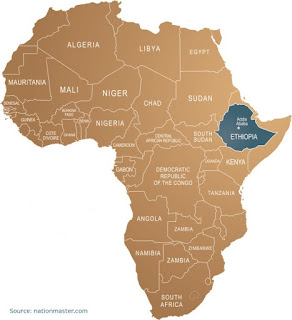Ethiopia's Dangerous Relationship With Food
In previous posts I have explored the climatic and demographic changes that Ethiopia is experiencing, such as declining precipitation. However, I haven’t really discussed the very real effects of Ethiopia’s fluctuating climate on the general population. In this post I’ll therefore draw attention to these often tragic impacts.
Agriculture is generally regarded as the most weather-reliant of all human activities, accordingly the effects of Ethiopia’s fluctuating climate on agricultural production is substantial. Most recently, the El Nino and Indian Ocean Dipole induced droughts (if you missed it, find my earlier post on these two natural phenomena here) highlights this dependency, with staggering consequences for food security, despite the economic advances discussed in my last post. At the height of the El Nino-induced 2015/16 drought, in April 2016, more than 10.2 million Ethiopians became dependent on food aid. The situation has not improved into this year, with 228 districts, of the 461 flagged as ‘in need’, being assessed as Priority 1, meaning life-saving assistance is urgently required. This is an increase of 19% from December 2016 and is largely a result of the continuing drought, with diminishing water for livestock, affecting income and consumption in the main drought-affected areas. In total, 7.8 million people were receiving food support by mid-2017. Evidently, regular drought conditions is resulting in dramatic food insecurity, with almost 35% of Ethiopians experiencing chronic food insecurity and, shockingly, just 40% of the population enjoys food security
The situation becomes ever more serious when viewed through the prism of the long-term declines in precipitation that I discussed a couple of weeks ago. Falls in precipitation has already resulted in the contraction of suitable agricultural land and the trend is expected to continue (see Figure 1). As I have already pointed out, the loss of arable land is in the most densely populated areas of the country, posing serious problems for food security. The resulting declines in arable farmland per capita have therefore been declining at a rate which, if it continues, will result in a per capita cereal production reduction of 28% by 2025, bringing the reality of malnourishment to millions more people.
Paradoxically, the intensifying of extreme weather is not only destabilising food security through drought, but also flooding events. Across Ethiopia, as with much of Sub-Saharan Africa, climatic changes are leading to an increasing number and severity of flood events. Figure 2 shows the extent of flooding during the Belg rains in 2016, with nearly half a million people affected. The Kiremt rains bring even more intense flood events, destroying 800 hectares of fruit and vegetables in July alone earlier this year. As Ethiopian agricultural production is overwhelmingly made up of small scale farms, such a loss of crop can prove devastating for thousands of families. This combination of both drought and flood events is therefore proving particularly challenging for current Ethiopian agricultural production.
 |
| Figure 2: Map showing flood affected areas during the 2016 Belf rains, alongside regions which regularly experience flooding. |
Declining agricultural output is especially important in Ethiopia, where agriculture is the primary livelihood strategy for most of the population. On top of this, as highlighted last week, agriculture makes up almost 50% of the nation's total GDP, and, with the vast majority of agricultural output coming from rain-fed crops and livestock, the national economy has become tightly coupled with climate conditions, most importantly precipitation. Figure 3 highlights this often troublesome relationship, with the drought years of 1984, 1991, 1994, 1997 and 2003 all leading to a sharp decline in GDP growth. Indeed, the 2003 drought resulted in a substantial 3.3% decline in GDP. Therefore, during drought years, not only are there grave insufficiencies in food supplies, but Ethiopia’s purchasing power declines, restricting the country’s food import ability and compounding issues of food insecurity. In fact, over the last 20 years Ethiopia has been the single largest recipient of food assistance in Africa, relying on food aid in one form or another virtually every year since the 1970s.
 |
| Figure 3: Real GDP growth by year, 1982 to 2017. Data from the IMF World Economic Outlook, April 2017. Major falls are often related to drought years and subsequent falls in agricultural production. |
The highly variable climate in Ethiopia is clearly having severe repercussions for food security. The stretched food assistance schemes is struggling to cope with the scale of the crisis and, as a result, there are approximately 376,000 severely malnourished children under 5 and 3.6 million moderately malnourished children and lactating women across Ethiopia. However, the effects of food insecurity go beyond immediate hunger and a recent qualitative study of children in Ethiopia highlights the impacts of an irregular food supply on a child’s development. It is suggested that food insecurity influences a child’s trajectory in a range of ways, affecting their education, work prospects and relationships. Evidently, achieving food security in Ethiopia is crucially important. It would promote economic development, support individual development and vastly improve quality of life. However, fluctuations in rainfall have been shown to be the primary factor influencing food security at the household level, with over 90% of food-insecure families experiencing rain shock. With extreme weather in Ethiopia set to continue as anthropogenic climate change and natural precipitation cycles collide, the prospects for improving food security seem uncertain. Over the next few posts I’ll be taking a look at how, or if, Ethiopia can improve its current situation.




Comments
Post a Comment